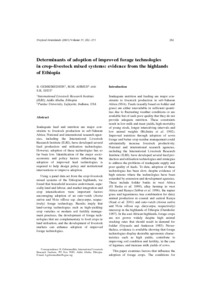Resource information
Inadequate feed and nutrition are major constraints to livestock production in sub-Saharan Africa. National and international research agencies, including the International Livestock Research Institute (ILRI), have developed several feed production and utilisation technologies. However, adoption of these technologies has so far been low. Identification of the major socio-economic and policy factors influencing the adoption of improved feed technologies is required to help design policy and institutional interventions to improve adoption. Using a panel data set from the crop-livestock mixed systems of the Ethiopian highlands, we found that household resource endowment, especially land and labour, and market integration and crop intensification were important factors encouraging adoption of an oats-vetch (Avena sativa and ITcia villosa ssdasycarpa, respectively) forage technology. Results imply that land-saving technologies such as high-yielding crop varieties or modern soil fertility management practices, the development of forage technologies that are complementary to food crops in land utilisation, and the development of livestock markets can enhance adoption of improved forage technologies.


